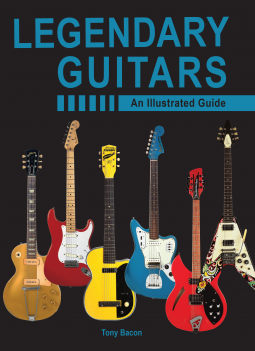
Legendary Guitars is an Illustrated guide to the guitars of the 50s and 60s. The book is full of great photos and great information about the history of all the different guitars that were put to good use in the 50s and 60s – when people were sick of watching TV and looking for new ways to entertain themselves. In the 50s, teenagers longed for Pop Music. “Pop Music’s shiniest icon was the electric guitar.” In the 60s, it was all about distortion to create “the most extraordinary music ever created.” The book gives a bit of history of what was going on in each of the years and then dives into the guitars from each of the years from 1950 – 1969. It is cool to see a bit of evolution amongst the guitar makers happening throughout the two decades.
I received a free e-copy of this book in order to write this review, I was not otherwise compensated.
About the Book
Legendary Guitars guides you through the electric guitars of the 1950s and ‘60s and the culture, styles, and music that shaped them.
“Finding ways to use the same guitar people have been using for 50 years, to make sounds no one has heard before, is truly what gets me off.” —Jeff Beck
Legendary Guitars: An Illustrated Guide recaps how the great instruments created and produced between 1950 and 1969 went on to define the design, looks, and playability of today’s electric guitars.
Legendary Guitars draws direct lines between the mid-century originals and many of today’s most highly-prized instruments. Alongside classic originals, you’ll see great examples of more recent instruments, showing how today’s guitar makers have produced fresh interpretations that draw on the venerable ‘50s and ‘60s templates. The guide details everything from highly accurate (and highly priced) vintage remakes and artist models to the broader influences and mashup qualities of modern retro creations.
The 1950s marked the birth of so many now-classic electric guitars: from the Gibson Les Paul and the Fender Telecaster (as seen with Bill Haley & His Comets and with Little Richard’s band) to the Gretsch 6120 and the Gibson Flying V (twanged by Duane Eddy and touted by Albert King).
In the 1960s, players pushed the sound of the electric guitar—bending, distorting, and overloading the instrument to within an inch of its life—all to fire some of the most extraordinary music ever created, not least by Jimi Hendrix with an upside-down Fender Stratocaster, Eric Clapton with a psychedelic Gibson SG, and George Harrison with a 12-string Rickenbacker.
The work of more than 50 guitar brands—past and present—is highlighted, including Airline, Ampeg, Antoria, Aria, Baldwin, Bigsby, Burns, Coral, Danelectro, Eko, Epiphone, Fender, Framus, Futurama, Gibson, Goya, Gretsch, Grimshaw, Guild, Guyatone, Hagstrom, Harmony, Hofner, Hopf, Ibanez, Kawai, Kay, Kent, Kustom, La Baye, Magnatone, Messenger, Micro-Frets, Mosrite, National, Rickenbacker, Silvertone, Stratosphere, Supro, Teisco Del Rey, Tokai, Vega, Vox, Wandre, Watkins, and Yamaha.
Alongside the eye-popping guitar photographs is a unique collection of classic advertisements, period catalogs, and other rare memorabilia. Legendary Guitars: An Illustrated Guide also contains a chronological narrative of world events that places these remarkable instruments in the context of two decades of mesmerizing contrasts and revolutionary invention.
Legendary Guitars takes you on an illustrated journey through the guitars and culture that drove the sound of rock ‘n’ roll, blues, and country, from 1950 to present day.